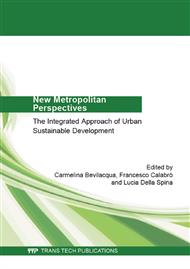[1]
Calavita, Nico & Alan Mallach: Inclusionary Housing in International Perspective: Affordable Housing, Social Inclusion, and Land Value Recapture; Lincoln Institute of Land Policy, Cambridge, Massachussetts (2010).
DOI: 10.5070/bp324111873
Google Scholar
[2]
P. Cohen, M. Fernando: Searching for the sweet spot in San Francisco. In: Libby Porter & Kathy Show, (2009), Whose Urban Renaissance? An International Comparison of Urban Regeneration Strategies, Routledge: London (2009).
Google Scholar
[3]
A. Fishman: Community Development Corporations' Strategies Against Gentrification and Displacement: Leading Community Movements in Park Slope, Brooklyn and in the Mission District of San Francisco, Master's Thesis, New York University Robert F. Wagner Graduate School of Public Service (2006).
Google Scholar
[4]
Marti, Fernando et. al.: Planning Against Displacement: A decade of progressive community-based planning in San Francisco's Mission District. In: Diagolos: Placemaking in Latino Communities, Michael Rios & Leonardo Vasquez, eds.; Routledge: London (2012).
DOI: 10.4324/9780203123676-19
Google Scholar
[5]
S. Dennis: Public Benefit Zoning and Community Involvement in San Francisco: The Case of the Eastern Neighborhood Plan. Paper presented at the Urban Affairs Conference, San Francisco, April (2013).
Google Scholar
[6]
Seifel Consulting Inc.: San Francisco Eastern Neighborhoods Nexus Study, prepared for the San Francisco Planning Department; May (2008).
Google Scholar
[7]
S. Dennis: Eastern Neighborhoods DRAFT Financial Analysis, Memorandum to interested parties. In: San Francisco Planning Department, Feb 27 (2008).
Google Scholar
[8]
City of San Francisco Planning Department, Planning Commission Documents June 2008 (An Executive Summary from Planning Department Staff, The Eastern Neighborhoods Financial Analysis, developed by Seifel Consulting Inc. Accessed on June 26, 2013. Information on: http: /www. sf-planning. org/Modules/ShowDocument. aspx?documentid=1335.
Google Scholar
[9]
Seifel Consulting Inc.: Eastern Neighborhood Impact Fee and Affordable Housing Analysis, Memorandum to Sarah Dennis, Planning Department, May (2008b).
Google Scholar
[10]
J. S. Kayden: Market-based Regulatory Approaches: A Comparative Discussion of Environmental and Land Use Techniques in the United States, 19 B.C. Envtl. Aff. Rev. 565, (1992). Information on: http: /lawdigitalcommons. bc. edu/earl/vol19/iss3/11.
Google Scholar


